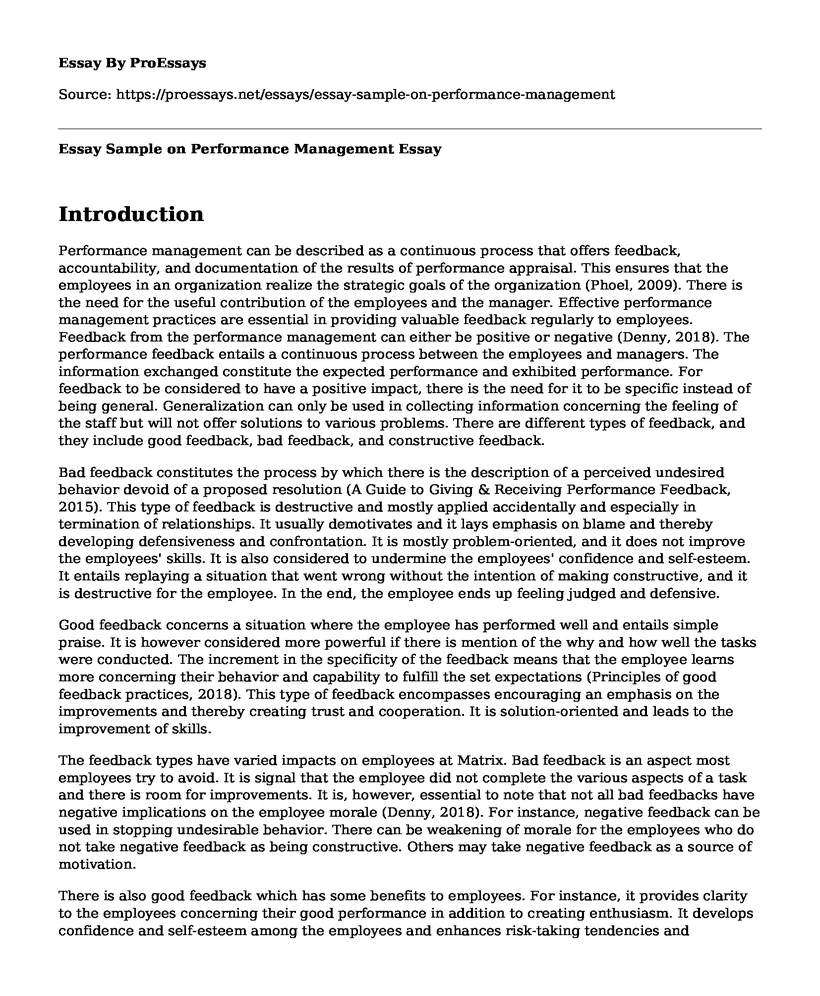Introduction
Performance management can be described as a continuous process that offers feedback, accountability, and documentation of the results of performance appraisal. This ensures that the employees in an organization realize the strategic goals of the organization (Phoel, 2009). There is the need for the useful contribution of the employees and the manager. Effective performance management practices are essential in providing valuable feedback regularly to employees. Feedback from the performance management can either be positive or negative (Denny, 2018). The performance feedback entails a continuous process between the employees and managers. The information exchanged constitute the expected performance and exhibited performance. For feedback to be considered to have a positive impact, there is the need for it to be specific instead of being general. Generalization can only be used in collecting information concerning the feeling of the staff but will not offer solutions to various problems. There are different types of feedback, and they include good feedback, bad feedback, and constructive feedback.
Bad feedback constitutes the process by which there is the description of a perceived undesired behavior devoid of a proposed resolution (A Guide to Giving & Receiving Performance Feedback, 2015). This type of feedback is destructive and mostly applied accidentally and especially in termination of relationships. It usually demotivates and it lays emphasis on blame and thereby developing defensiveness and confrontation. It is mostly problem-oriented, and it does not improve the employees' skills. It is also considered to undermine the employees' confidence and self-esteem. It entails replaying a situation that went wrong without the intention of making constructive, and it is destructive for the employee. In the end, the employee ends up feeling judged and defensive.
Good feedback concerns a situation where the employee has performed well and entails simple praise. It is however considered more powerful if there is mention of the why and how well the tasks were conducted. The increment in the specificity of the feedback means that the employee learns more concerning their behavior and capability to fulfill the set expectations (Principles of good feedback practices, 2018). This type of feedback encompasses encouraging an emphasis on the improvements and thereby creating trust and cooperation. It is solution-oriented and leads to the improvement of skills.
The feedback types have varied impacts on employees at Matrix. Bad feedback is an aspect most employees try to avoid. It is signal that the employee did not complete the various aspects of a task and there is room for improvements. It is, however, essential to note that not all bad feedbacks have negative implications on the employee morale (Denny, 2018). For instance, negative feedback can be used in stopping undesirable behavior. There can be weakening of morale for the employees who do not take negative feedback as being constructive. Others may take negative feedback as a source of motivation.
There is also good feedback which has some benefits to employees. For instance, it provides clarity to the employees concerning their good performance in addition to creating enthusiasm. It develops confidence and self-esteem among the employees and enhances risk-taking tendencies and innovation (Flanagan, 2017). It is also a form showing care and involvement and makes the employee feel that the efforts have been acknowledged. It is most appropriate when recognizing specific task performance that is as per the expectation or has exceeded.
References
A Guide to Giving & Receiving Performance Feedback. (2015). Ocpe.nt.gov.au. Retrieved 10 April 2018, from https://ocpe.nt.gov.au/__data/assets/pdf_file/0004/247900/A_Guide_to_Giving_and_Receiving_Performance_Feedback.pdf
Denny, J. (2018). The Right Balance: Positive VS. Negative Feedback at Work. Growth Engineering. Retrieved 10 April 2018, from http://www.growthengineering.co.uk/positive-vs-negative-feedback-work/
Flanagan, S. (2017). Performance Management: Giving and Receiving Feedback. Hr.psu.edu. Retrieved 10 April 2018, from https://hr.psu.edu/sites/ohr/files/GivingAndReceivingFeedbackSupervisors.pdf
Phoel, C. (2009). Feedback That Works. Harvard Business Review. Retrieved 10 April 2018, from https://hbr.org/2009/04/feedback-that-works
Principles of good feedback practices. (2018). Flinders.edu.au. Retrieved 10 April 2018, from http://www.flinders.edu.au/teaching/teaching-strategies/assessment/feedback/good-feedback.cfm
Cite this page
Essay Sample on Performance Management. (2022, Apr 19). Retrieved from https://proessays.net/essays/essay-sample-on-performance-management
If you are the original author of this essay and no longer wish to have it published on the ProEssays website, please click below to request its removal:
- Business Paper Example on Strategic Plan Development
- BHF Restaurant Business Plan
- Justice Ruth Bader Ginsberg Essay
- Essay Sample on Paul's Teaching on Leadership: Reframing for Contemporary Church
- Essay Sample on Leaders: God-Gifted to Transform & Guide the World
- Essay Sample on Mark Zuckerberg: A Humble and Visionary Leader
- Paper Sample on Importance of SWOT Analysis in Strategic Planning







